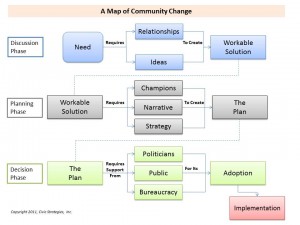Incremental change is change by the inch, and it’s what wise leaders do over long periods. In his 12 years in office, Mayor Michael Bloomberg remade huge swaths of New York, rezoning 40 percent of the city, but he did it so quietly that few noticed at the time.
In his 31 years in office, Charleston, S.C. Mayor Joseph Riley had an even subtler impact on his city. Yes, there were big things he facilitated—the launching of the Spoleto arts festival, for one—but Riley’s true legacy is in the fabric of the city, the way streets were tended, buildings cared for, and parks placed. Under Riley’s long watch, Charleston became a national treasure.
Other longtime mayors have had that kind of impact on cities. Boston’s late mayor, Thomas Menino, once declared that “visionaries don’t get things done” and denied that he had a vision for his city. He preferred the term “urban mechanic.” But Menino’s steady tinkering with services and amenities made Boston gleam as never before.
So, yes, we need steady, incremental change. But, with apologies to Mayor Menino, sometimes we also need great leaps, the kind of visionary projects he disdained. This is especially so in cities that are depressed or dispirited, that need a change of direction or attitude.
So what is a great project? It can be anything that signals a new direction: a stylish convention center, a 21st century transit system, a signature downtown park, a beautiful riverwalk, an exciting arts center. One mayor described these things as “man on the moon” projects–efforts that are bold, visible, a clear break from the past, and undeniably successful.
I’ve studied great projects for years, tracing how they came to be, who supported them and at what point, the obstacles they faced and overcame, and why they ultimately succeeded. And I’ve noticed some common elements among these otherwise very different undertakings. Here are seven:
- Most great projects start outside city hall. That is, they begin with a citizens group or nonprofit that brings its idea to city hall. Smart elected officials aren’t threatened by these outside ideas; they welcome them.
- They depend on collaborations to succeed. This may be why so many successful projects start outside city hall. By the time the government is involved, partners are already in place.
- There’s something in the project that resonates with the public, even if it isn’t apparent why. This is why elected officials should ask those advancing a big project to take their idea to the public before asking for city hall’s support. After all, who knew New York needed a linear park 30 feet above street level before the organizers of the High Line project created a demand for it?
- The turning point is when a leader sees the way forward. This is where political leadership becomes crucial. A great project can grow organically but only to a point. For the project to succeed, someone in power has to figure out how to overcome its obstacles and structure the project for success. This can involve a small group, but in most cases it’s the work of a single experienced leader.
- In the structure that emerges, the city’s role remains limited. Average leaders seize control of projects, but great ones are comfortable sharing the wheel. That’s because they know that, if you lose the collaboration, you lose the energy, creativity, and resources that partnerships bring.
- As the project advances, other interests will support the project for reasons that are wholly unrelated to yours. This doesn’t mean the project has lost focus. It’s usually a result of the excitement the project is generating. So take this as a sign of success.
- When the project is completed, a whole new set of challenges will present themselves, and smart leaders will anticipate them as well. Nothing is sadder than yesterday’s great project that has fallen on hard times (say, New York’s Central Park in the 1970s). The time to think about long-term support is before the project is finished. Here again, collaboration is the key. After all, mayors come and go, and their interest in parks may wax and wane, but the Central Park Conservancy remains focused—and is here to stay.
Can a leader be both an incrementalist and a visionary? Well, yes, but it may be the wrong question to ask. A better question is, what does your city need at this time—a great project or steady progress? If the wind is at your city’s back, incremental change may be all it needs. But if the wind shifts, you may need something big and bold. When that happens, keep an eye out for ideas from the outside that arrive with a few good habits.
A version of this posting appeared on the Governing website.
Photo by M.V. Jantzen licensed under Creative Commons.

